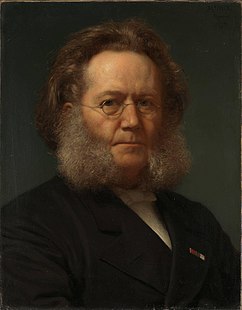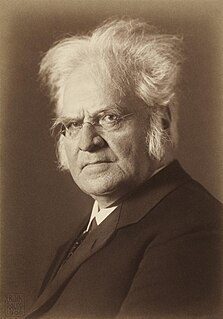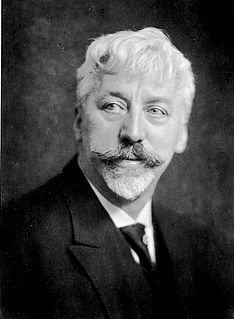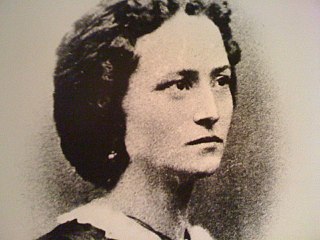
Andreas Hornbeck Isachsen (31 May 1829, Grimstad - February 22, 1903, Cologne) was a Norwegian actor and playwright. [1]

Andreas Hornbeck Isachsen (31 May 1829, Grimstad - February 22, 1903, Cologne) was a Norwegian actor and playwright. [1]
In 1850, still a student, Isachsen briefly edited the student-society newspaper Samfundsbladet alongside the future playwright Henrik Ibsen. On 18 January 1852 he made his debut as an actor at Det norske Theater in Bergen as Ruy Gomez in the one act play Man kan hvad man vil (One can what one wants). He was employed in Bergen until 1858, when he left the stage for a time. On 10 November 1853, in Bergen, he married the actress Janny Grip (1835-1894).
He resumed acting in 1860 at the Christiania Norwegian Theatre, then under Ibsen's artistic direction. He remained in that company until the theatre went bankrupt in 1862, on which he moved to the theatre in Trondheim. In 1865 he returned to the Christiania Theatre, but joined Bjørnstjerne Bjørnson's walkout to the Folketheater at Møllergaten, where he acted from September 1870 to February 1872. From 1872 until his retirement from the stage in 1894, Isachsen remained at the Christiania Theatre.
Isachsen was known as a character actor with a particular talent for comedic roles. Isachsen argued with Ibsen over an 1873 play reading of Emperor and Galilean held at Christiania on his own initiative. He had previously held readings of lyric poems by Peter Christen Asbjørnsen and Moe, receiving praise for them from Asbjørnsen himself. Relations between Isachsen and Ibsen remained soured for the rest of Isachsen's career - Ibsen wrote a letter to the theatre's management specifically demanding that "the terrible Isachsen" would not be given any parts, since Ibsen felt he had a tendency towards over-acting and caricaturing roles.

Henrik Johan Ibsen was a Norwegian playwright and theatre director. As one of the founders of modernism in theatre, Ibsen is often referred to as "the father of realism" and one of the most influential playwrights of his time. His major works include Brand, Peer Gynt, An Enemy of the People, Emperor and Galilean, A Doll's House, Hedda Gabler, Ghosts, The Wild Duck, When We Dead Awaken, Rosmersholm, and The Master Builder. Ibsen is the most frequently performed dramatist in the world after Shakespeare, and A Doll's House was the world's most performed play in 2006.

Bjørnstjerne Martinius Bjørnson was a Norwegian writer who received the 1903 Nobel Prize in Literature "as a tribute to his noble, magnificent and versatile poetry, which has always been distinguished by both the freshness of its inspiration and the rare purity of its spirit". The first Norwegian Nobel laureate, he was a prolific polemicist and extremely influential in Norwegian public life and Scandinavian cultural debate. Bjørnson is considered to be one of the four great Norwegian writers, alongside Ibsen, Lie, and Kielland. He is also celebrated for his lyrics to the Norwegian national anthem, "Ja, vi elsker dette landet". The composer Fredrikke Waaler based a composition for voice and piano (Spinnersken) on a text by Bjørnson, as did Anna Teichmüller.

Johan Peter Broust Fahlstrøm was one of Norway's leading male actors before World War I.

Gunnar Edvard Rode Heiberg was a Norwegian poet, playwright, journalist and theatre critic.

Erik Theodor Werenskiold was a Norwegian painter and illustrator. He is especially known for his drawings for the Asbjørnsen and Moe collection of Norske Folkeeventyr, and his illustrations for the Norwegian edition of the Snorri Sturlason Heimskringla.

Christiania Theatre, or Kristiania Theatre, was Norway's finest stage for the spoken drama from 4 October 1836 to 1 September 1899. It was located at Bankplassen by the Akershus Fortress in central Christiania. It was the first lasting public theatre in Norway and the national stage of Norway and of Oslo during the 19th century.

Laura Sofie Coucheron Gundersen was a Norwegian actress, counted as the first native-born tragedienne, and also, in some aspect, as her country's first professional native actress and prima donna. She was associated with Christiania Theater from her debut in 1850 until her death, except for the seasons 1870-72, when she played at Møllergatens Theater.

Johanne Dybwad was a Norwegian stage actress and stage producer. She was the leading actress in Norwegian theatre for half a century.

Egil Næss Eide was a Norwegian silent film actor and director. He appeared in eighteen films between 1913 and 1935, and worked at the National Theatre between 1899 and 1939.

Hans Wiers-Jenssen was a Norwegian novelist, playwright, stage producer and theatre historian. Wiers-Jenssen was employed at the theatres Christiania Theatre, Nationaltheatret and Den Nationale Scene.

Anna Magdalene Thoresen, née Kragh was a Danish-born Norwegian poet, novelist, short story writer and playwright. She is said to have inspired a number of other writers to model characters after her. Her stepdaughter, Suzannah Ibsen, was married to Henrik Ibsen.

Dorotheus Olivarius "Dore" Lavik was a Norwegian actor and theatre director. He worked as an actor at Den Nationale Scene in Bergen from 1895, and chaired the theatre Sekondteatret in Kristiania from 1899 to 1901, together with his wife Ludovica Levy.
Christiania Norwegian Theatre was founded in 1852 under the name of Norwegian Dramatic School, and later renamed Christiania Norwegian Theatre. The initiative came from lieutenant engineer Johannes Benedictus Klingenberg (1817–1882) after he had been disappointed by the un-Norwegian repertoire selection and had visited the Norwegian Theatre in Bergen. In 1854 the drama school was made into a performing arts theater.

Ole Paus was a Norwegian iron and steel industrialist and Chairman of the commercial bank Den norske Creditbank. He was a first cousin of Henrik Ibsen.

Fredrikke Louise Nielsen, was a popular Norwegian actress and a women's pioneer. She played more than 300 roles in her twenty-six-year-long career, and was personally directed by both Henrik Ibsen and Bjørnstjerne Bjørnson. Ibsen chose her to play Signe, one of the lead characters in The Feast at Solhaug (1856), which was his first audience success. In 1880, Nielsen left the stage and joined the Methodist Movement in Bergen. She now became a preacher, first in Scandinavia, and later in the United States. She felt a strong social commitment and used the pulpit for preaching other topics than religion, such as women's and children's rights.

Sofie Marie Parelius was a Norwegian stage actress. She was known for her ability in comedy and viewed as one of the best Norwegian actor during her time of the classic works of Ludvig Holberg. She belonged to the elite of the actors at the Christiania Theatre in the second half of the 19th-century, when Norwegian actors successively replaced the Danish on Norway's national stage.

Janny Grip Isachsen was a Norwegian stage actress.

Camilla Theodora Antonsdatter Wiese was a Norwegian mezzo-soprano and voice teacher.

Johanne Voss was a Norwegian actress from Bergen.

Jens Andreas Ludvig Selmer was a Norwegian stage actor and a film actor from the silent-film era.